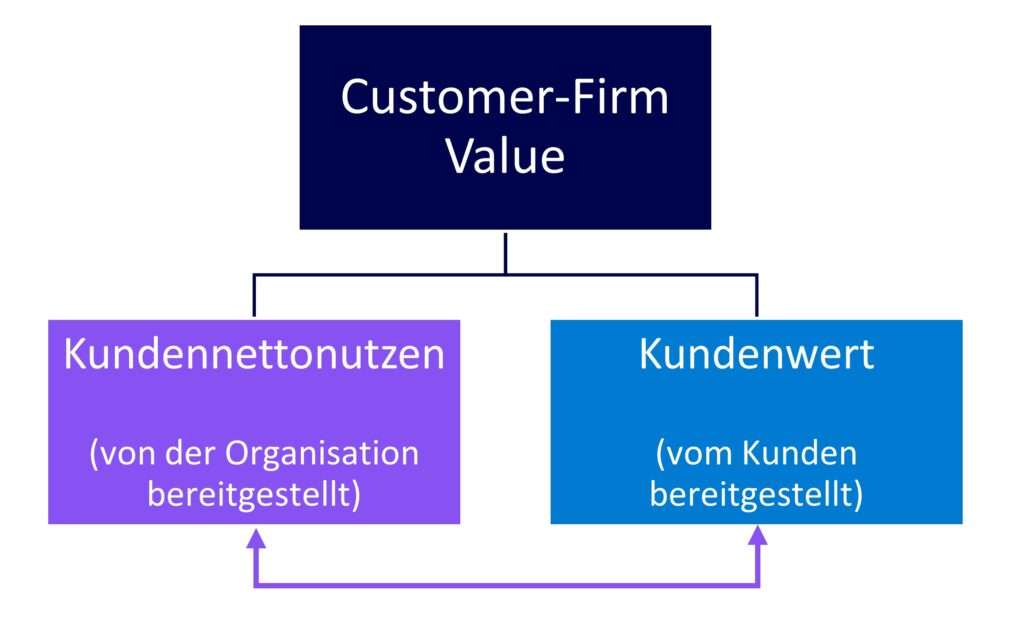The Customer Value-based Decision Making dimension refers to decision making that systematically increases value for customers, but also for the organization. In the literature, a heterogeneous understanding of the terms customer value and customer value has developed. In addition, each organization has established its own understanding of these terms. In the following, a conceptual distinction, which is elementary for understanding and improving customer orientation, must be made for the definition of customer value. Customer value in the understanding of customer orientation is customer-firm value. This is the comparison of the value to the customer by the organization with the value of the customer to the organization. Since up to now this conflation has mostly been ignored and the term Customer Value has been used in a simplified way, we speak of Customer-Firm Value instead of Customer Value against the background of the existing understanding of the term in order to emphasize the duality of the term. Customer value-based decision making actually refers to customer-firm value- ased decision making.
Customer-Firm Value contrasts the value of the organization to the customer with the value of the customer to the organization. It serves as a basis for decision-making to systematically increase value for both customers and the organization.
Customer-Firm Value is two-dimensional and the basis of customer-centric decision making in an organization to drive organizational growth and profit. It can be determined on an individual level or aggregated for the entire customer base. In practice, both the assessment of value to customers and value to the organization are usually done in an unsystematic, irregular and methodologically undemanding manner. In addition, the calculations are also rather rarely used for decision making. While there is a lot of talk about customer focus, when it comes to implementation, an organization’s customer-centric value management is done with the simplest tools that exist. The fact that the instruments used are more than 50 years old is commented on by more than a few people with the words: “Exactly, it has proven itself super”, or: “Let’s not introduce anything too complicated”.

However, to improve an organization’s customer orientation, the use of a customer-firm values model is imperative. The starting point for determining customer-firm value is two different value constructs. Different customers deliver different value propositions to an organization. For many B2B organizations, 20% of customers account for 80% of sales. Conversely, the benefit of an offer/brand is assessed differently by each individual customer. Beyond the pure systematics, it is important to note that customer-firm value should not be seen as a single transaction. It presupposes that an organization understands a relationship with the customer in the period. The value understanding of customer orientation refers to the development of the relationship over time. This places high demands on data extraction and use within decisions. Thus, it is challenging for many organizations to determine the net customer benefit – especially when there is no direct customer relationship and the sale is made through a trading partner. It has been shown in practice that organizations that take on this challenge piece by piece are significantly more successful than organizations that bury their heads in the sand or launch overly ambitious projects in this area. Customer Value-based Decision Making is challenging, but an elementary basis of customer orientation.
Definition customer value
Customer value describes the current value of a customer’s future profit
throughout its relationship with an organization. The sum of all individual customer values of an organization results in the customer equity.
The definition of customer value presented shows that this is divided into two basic dimensions: increasing sales as much as possible and reducing costs as much as possible. Not both are possible with every customer. The only thing to note is that this definition of customer value is not just about increasing sales. If the sales data per customer is usually still available, the cost analysis is usually a major challenge on a day-to-day basis. From the organization’s point of view, the customer value calculation allows the targeted deployment of resources; be it the targeted deployment of sales staff, the individual offering of discount promotions, the selection of customers to be invited to events, or the deployment of customer relationship campaigns. Only on the basis of the customer value is it possible to assess for which customers which measures are value-enhancing from the organization’s point of view. Customers no longer appear as a homogeneous mass, but are systematically evaluated and compared. The use of a customer value is also so important in order to weight customer acquisition and retention of an organization as optimally as possible. Leveraging customer value offers another benefit to an organization: it helps drive the organizational transformation that is so critical to customer centricity and lays an important foundation for co-creation. In addition, a customer value model can help reduce tension between departments by contributing to greater transparency in employee, team, departmental evaluation. The bottom line is to use the model to decide which customers to acquire, how they should be handled, and which customers the organization should part with. In this context, the so-called “80:20” rule should be taken into account, especially in the B2B context. Approximately 20% of customers account for 80% of total sales. Despite these advantages, very few organizations still use a customer value model for strategic and operational decision making. Customer value does not have a past-oriented revenue perspective in the context of customer orientation. The term customer value refers to the future and is intended to help support decisions for the future development of an organization.
Our offer in the field of customer orientation Consulting
Kundenorientierung ist in aller Munde. Dabei reicht es nicht aus, begeisternde bzw. möglichst einfache Erlebnisse zu definieren. Es gilt, die Anpassungsfähigkeit des Unternehmens an Veränderungen im Einkaufsverhalten der Kunden sicherzustellen. Als spezialisierte Beratung Kundenorientierung verfügen wir über Tools und Erfahrungen, Dich bei Deiner Transformation zur Verbesserung der Kundenorientierung erfolgreich zu unterstützen.
Das Buch zum Thema
The topic of customer value is presented comprehensively in the book Customer Orientation starting on page 210. Practical examples are also provided and additional recommendations are made for the individual levels. A deeper understanding of how to create and use a customer value model is worthwhile.





